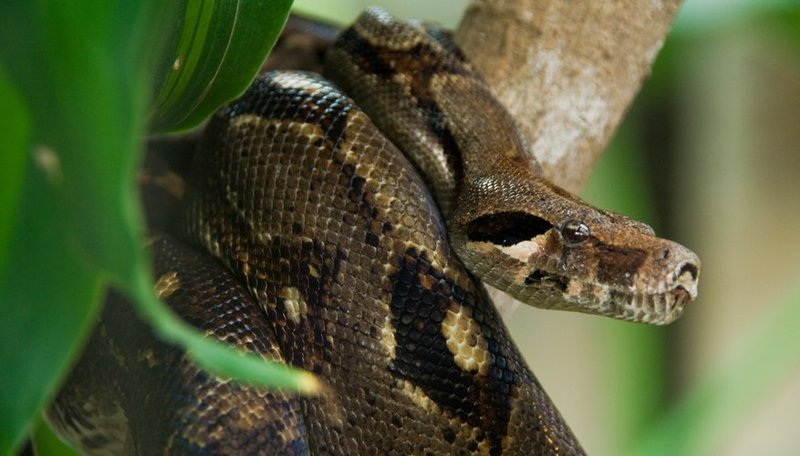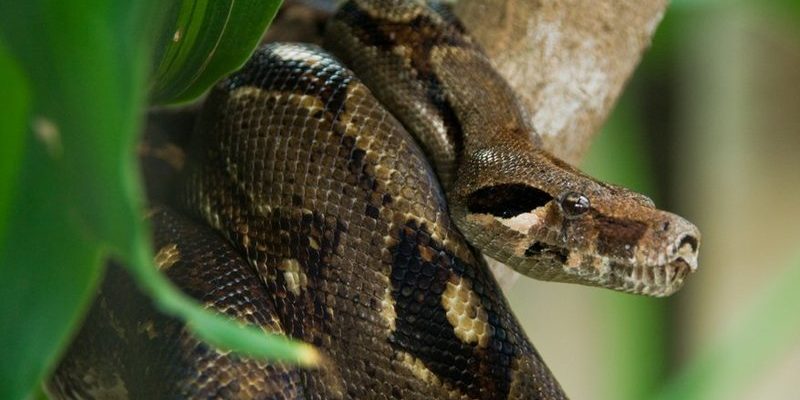
Imagine a tank of a snake, coiled up and completely at home in the murky waters of the Amazon. With its incredible size and strength, the green anaconda is like a well-designed survival machine. Every part of this snake is tailored for its lifestyle, from the way it hunts to how it protects itself. So, let’s dive into some of the amazing adaptations that make the green anaconda a true survivor.
Size and Strength: Nature’s Design
One of the first things people notice about the green anaconda is its massive size. These snakes can grow to be over 29 feet long and weigh more than 550 pounds! This size isn’t just for show; it serves multiple purposes.
To give you an idea, imagine being the biggest kid in class—everyone notices you, right? The green anaconda uses its size to intimidate potential threats and unsuspecting prey. When it comes to hunting, bigger is often better. The anaconda can easily overpower large animals like deer, pigs, and even caimans. This means that it can take on prey that smaller snakes simply can’t handle.
Additionally, the anaconda’s muscular body allows it to constrict its prey with incredible force. When it wraps around an animal, it doesn’t just hold it tight; it squeezes until the prey can’t breathe anymore. It’s an efficient hunting method that showcases how size and strength work hand in hand.
Camouflage: Blending In
Another critical adaptation for the green anaconda is its camouflage. The snake’s green and brown scales help it blend seamlessly into the murky waters and lush vegetation of its habitat. It’s like wearing a natural disguise that allows it to stay hidden from both predators and prey.
Think about how you might hide on a nature walk by wearing earth tones. The green anaconda takes this to the next level. When it’s lying in the water with just its eyes and nostrils peeking out, it can be nearly impossible to spot. This stealthy approach is essential for ambushing prey, which is a big part of its hunting strategy.
If you ever find yourself in the Amazon rainforest, you might spend hours looking for one of these giants, only to realize it’s right in front of you! This is a perfect example of how effective camouflage can be for survival.
Behavioral Adaptations: Flexibility in Tactics
The green anaconda isn’t just about physical adaptations; its behaviors also play a key role in its survival. For instance, these snakes are quite versatile when it comes to hunting. They don’t rely on just one strategy; instead, they adapt based on what’s available.
For example, anacondas can stay submerged in water for long periods, allowing them to ambush animals coming to drink. This ability to remain still for hours shows how patience is just as important as strength. They are also good swimmers, using their powerful tails to navigate swiftly through the water.
This behavioral flexibility extends to their mating habits as well. During the mating season, males will often form a “breeding ball,” where several males wrap around a single female. This not only increases their chances of mating but also ensures genetic diversity. It’s all about making the most of what they have!
Diet: Opportunistic Feeding
The green anaconda is an opportunistic feeder, meaning it will eat whatever meal presents itself. Its diet mainly consists of large mammals, birds, and fish, but it can also take on smaller reptiles when needed. This adaptability in diet is crucial for survival, especially in habitats where food sources can be scarce.
Imagine going to a buffet where you can choose from anything you fancy. That’s how the green anaconda approaches food! When hunting, it uses a “sit-and-wait” strategy, remaining motionless until the perfect moment to strike. Once it spots its prey, it lunges forward with lightning speed, often catching its meal by surprise.
The ability to eat a wide range of foods helps ensure that the anaconda can survive in various conditions. When times are tough, it’s always beneficial to have a diverse menu.
Reproductive Strategies: Ensuring the Future
Reproduction is another critical adaptation for the green anaconda. Female anacondas can give birth to dozens of baby snakes at once, which is a significant advantage in the wild. Once born, these young snakes are on their own and must fend for themselves immediately.
This strategy of having many offspring increases the chances that at least a few will survive to adulthood. Think of it as throwing a lot of seeds in the air and hoping that some land in fertile soil.
Interestingly, female anacondas can also store sperm for several months after mating. This means they can fertilize their eggs when conditions are just right, ensuring better survival for their young.
Habitat: Mastering the Swamp
The green anaconda primarily resides in swamps, marshes, and slow-moving streams. This choice of habitat is strategic. These environments provide ample cover for stalking prey and hiding from threats.
Swamps are rich in biodiversity, giving the anaconda access to various food sources that other predators might struggle with. Additionally, the water helps the anaconda maintain its massive body temperature, as they are ectothermic, meaning they rely on external sources to warm up.
Living in such habitats allows the green anaconda to take advantage of its surroundings. The murky waters not only provide shelter but also make it harder for prey to detect the snake’s approach. In this way, the habitat itself becomes a crucial part of the anaconda’s survival toolkit.
The green anaconda is a marvel of nature, showcasing an impressive array of adaptations that help it thrive in the wild. From its massive size and camouflage to its opportunistic feeding habits and reproductive strategies, every aspect of this snake has evolved to ensure its survival.
In the face of challenges, the green anaconda exemplifies resilience and adaptability. So, the next time you think about the survival of the fittest, remember this incredible snake. It’s more than just a predator; it’s a symbol of how nature can craft extraordinary solutions to the challenges of life in the wild.

